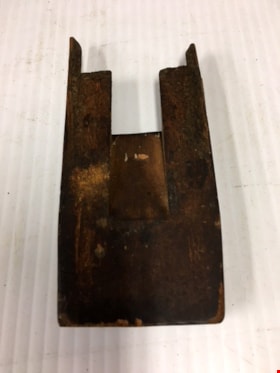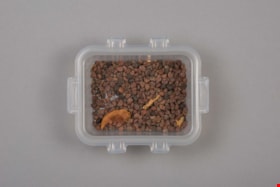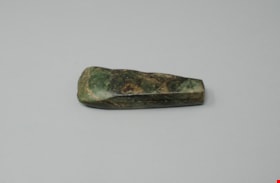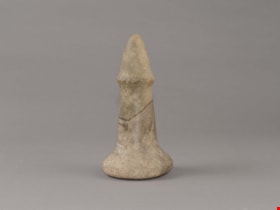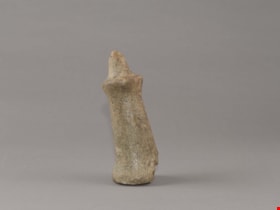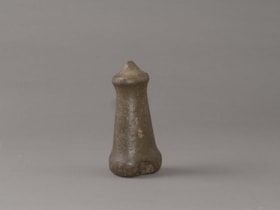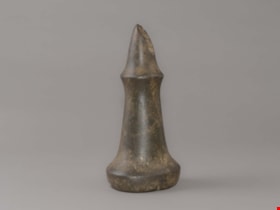Narrow Results By
plane wedge
https://search.heritageburnaby.ca/link/museumartifact23588
- Repository
- Burnaby Village Museum
- Accession Code
- HV976.251.11
- Description
- A wooden wedge which is part of a plane. It has a notch in the center with two pointed extensions on each side one of which is longer than the other. Markings are not visible.
- Object History
- Donor states that object had been owned by carpenter Wilfred Thomas Grimes of Halley Avenue in South Burnaby, ca. 1890-1940.
- Category
- 04.Tools & Equipment for Materials
- Classification
- Woodworking T&E
- Object Term
- Plane
- Measurements
- Overall measurements: Length: 13.6 cm Width: 6.3 cm Thickness: 1.5 cm
- Names
- Grimes, Wilfred Thomas
Images
botanical specimen
https://search.heritageburnaby.ca/link/museumartifact88671
- Repository
- Burnaby Village Museum
- Accession Code
- BV017.7.43
- Description
- English Name: Pharbitis Seed / Lobedleaf Pharbitis Seed Chinese Pinyin Name: Qianniuzi (QianNiuZi) Physical Description: many small dried seeds, colours vary from light tan to dark brown; wedge-shaped with curved backs, like orange segments; backs have single groove Production Regions: Primarily produced in the Chinese provinces of Guangxi, Yunnan. Functions: Drains water, frees stools, eliminates phlegm, clears fluid, kills worms, attacks stagnation. Apply to edema and fullness, fecal and urinary stoppage, inverse qi and panting, worm stagnation and abdominal pain, ascariasis, taeniasis.
- Object History
- Collection of original raw contents of the Chinese Herbalist Shop, Way Sang Yuen Wat Kee, Victoria BC, as purchased from Rodney Pain in 1974.
- Reference
- Chinese Medicinal Material Images Database, School of Chinese Medicine, Hong Kong Baptist University. URL: http://libproject.hkbu.edu.hk/was40/detail?channelid=47953&lang=eng&searchword=pid=B00198 Compendium of Materia Medica (Bencao Gangmu), 2003; Taiwan Herbal Pharmacopeia, 2014.
Images
chisel
https://search.heritageburnaby.ca/link/museumartifact38885
- Repository
- Burnaby Village Museum
- Accession Code
- BV998.11.1
- Description
- Chisel shaped tool, wedge-shaped; mainly green with white and brown fissures throughout. One side has elevated edge, possibly for attaching to handle.
- Object History
- The stone chisel was found by Archie Card, ca 1930 in the yard of the Card family home at 329 Richmond Street (later renamed Elwell) in Burnaby.
Images
Documents
hand maul
https://search.heritageburnaby.ca/link/museumartifact15555
- Repository
- Burnaby Village Museum
- Accession Code
- HV983.32.13
- Description
- Nipple topped stone maul. Nipple topped stone maul. It has a crack through the entire shaft and the two halves look of different colour and stone type. There is a large chip missing along the crack.
- Object History
- The donor was of European decent and was given this maul by an unidentified person. In general, hand mauls are used in woodworking todrive antler wedges or spreading sticks into logs and split planks. They were also used in combination with chisels for detail work. Their presence at an archeological site is viewed as evidence of long term habitations. They are associated with house building, canoe building, housepost and welcome figure carving. Nipple top hand mauls are identified as Marpole Culture (400 BC - 400 AD).
- Country Made
- Canada
- Province Made
- British Columbia
- Culture
- First Nations
- Subjects
- Persons
- Indigenous peoples - British Columbia
- Woodworking Tools and Equipment
- Woodworking Tools and Equipment - Maul
Images
Documents
hand maul
https://search.heritageburnaby.ca/link/museumartifact34041
- Repository
- Burnaby Village Museum
- Accession Code
- BV991.26.1
- Description
- Conical topped stone maul; damaged area on one side; broken area at bottom edge.
- Object History
- Maul was found in the late 1920s by Joseph Theodore Dorman on his property on Cliff Avenue, between Halifax and Broadway. In general, hand mauls are used in woodworking todrive antler wedges or spreading sticks into logs and split planks. They were also used in combination with chisels for detail work. Their presence at an archeological site is viewed as evidence of long term habitations. They are associated with house building, canoe building, housepost and welcome figure carving. Nipple top hand mauls are identified as Marpole Culture (400 BC - 400 AD).
- Country Made
- Canada
- Province Made
- British Columbia
- Subjects
- Persons
- Indigenous peoples - British Columbia
- Woodworking Tools and Equipment
- Woodworking Tools and Equipment - Maul
Images
Documents
hand maul
https://search.heritageburnaby.ca/link/museumartifact44853
- Repository
- Burnaby Village Museum
- Accession Code
- BV002.57.1
- Description
- Nipple topped stone maul. It has a pointed tip and a slight indentation on side of base. There is adhesive residue on bottom of base.
- Object History
- The donor inherited this artifact from his mother, Katherine Maude (Kitty) Peers, who inherited them from her father, Louis Claude Hill. The artifacts were found on his farm, Brookfield Farm, at Douglas Road and Sperling Avenue (now site of Burnaby Village Museum). In general, hand mauls are used in woodworking todrive antler wedges or spreading sticks into logs and split planks. They were also used in combination with chisels for detail work. Their presence at an archeological site is viewed as evidence of long term habitations. They are associated with house building, canoe building, housepost and welcome figure carving. Nipple top hand mauls are identified as Marpole Culture (400 BC - 400 AD).
- Subjects
- Persons
- Indigenous peoples - British Columbia
- Woodworking Tools and Equipment
- Woodworking Tools and Equipment - Maul
- Archeological Specimen
- Historic Neighbourhood
- Burnaby Lake (Historic Neighbourhood)
Images
Documents
hand maul
https://search.heritageburnaby.ca/link/museumartifact44854
- Repository
- Burnaby Village Museum
- Accession Code
- BV002.57.2
- Description
- Conical topped stone maul; damaged by a plow.
- Object History
- The donor inherited this artifact from his mother, Katherine Maude (Kitty) Peers, who inherited them from her father, Louis Claude Hill. The artifacts were found on his farm, Brookfield Farm, at Douglas Road and Sperling Avenue (now site of Burnaby Village Museum).
- In general, hand mauls are used in woodworking todrive antler wedges or spreading sticks into logs and split planks. They were also used in combination with chisels for detail work. Their presence at an archeological site is viewed as evidence of long term habitations. They are associated with house building, canoe building, housepost and welcome figure carving. Flat and conical topped hand mauls are identified as Gulf of Georgia Culture (400 AD - 1800).
- Subjects
- Persons
- Indigenous peoples - British Columbia
- Woodworking Tools and Equipment
- Woodworking Tools and Equipment - Maul
- Archeological Specimen
- Historic Neighbourhood
- Burnaby Lake (Historic Neighbourhood)
